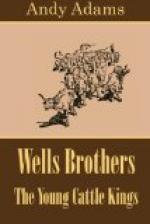The conception of a trail refuge had taken root. The supply points were oases for amusement, but a halfway haven for the long stretches of unsettled country, during the exodus of Texas cattle to the Northwest, was an unknown port. The monotony of from three to five months on the trail, night and day work, was tiring to men, while a glass of milk or even an hour in the shade was a distinct relief. Straw was reluctant to go, returning to make suggestions, by way of excuse, and not until forced by the advancing day did he mount and leave to overtake his herd.
Again the trio was left alone. Straw had given Forrest a list of brands and a classification of the cattle contributed, and a lesson in reading brands was given the boys. “Brands read from left to right,” said Forrest to the pair of attentive listeners, “or downward. If more than one brand is on an animal, the upper one is the holding or one in which ownership is vested. Character brands are known by name, and are used because difficult to alter. There is scarcely a letter in the alphabet that a cattle thief can’t change. When a cow brute leaves its home range, it’s always a temptation to some rustler to alter the brand, and characters are not so easily changed.”
The importance of claiming the range was pressing, and now that cattle were occupying it, the opportunity presented itself. A notice was accordingly written, laying claim to all grazing rights, from the Texas and Montana trail crossing on Beaver to the headwaters of the same, including all its tributaries, by virtue of possession and occupancy vested in the claimants, Wells Brothers. “How does that sound?” inquired Forrest, its author, giving a literal reading of the notice. “Nothing small or stingy about that, eh? When you’re getting, get a-plenty.”
“But where are we to get the cattle to stock such a big country?” pondered Joel. “It’s twenty miles to the head of this creek.”
“We might as well lay big plans as little ones. Here’s where we make a spoon or spoil a horn. Saddle a horse and post this notice down at the trail crossing. Sink a stake where every one can see it, and nail your colors to the sign-board. We are the people, and must be respected.”
Joel hastened away to post the important notice. Dell was detailed on sentinel duty, on lookout for another herd, but each trip he managed to find some excuse to ride among the cattle. “What’s the brand on my white cow?” inquired Forrest, the object leading up to another peculiarity in color.
“I couldn’t read it,” said Dell, airing his range parlance.
“No? Well, did you ever see a white cow with a black face?” inquired the wounded man, coming direct to the matter at issue.
“Not that I remember; why?”
“Because there never lived such a colored cow. Nature has one color that she never mars. You can find any colored cow with a white face, but you’ll never find a milk-white cow with a colored face. That line is drawn, and you want to remember it. You’ll never shoot a wild swan with a blue wing, or see yellow snowflakes fall, or meet a pure white cow with a black face. Hereafter, if any one attempts to send you on a wild-goose chase, to hunt such a cow, tell them that no such animal ever walked this earth.”




